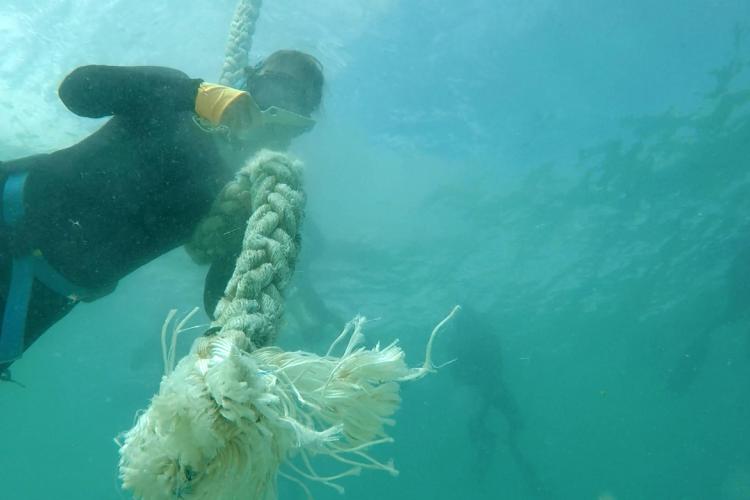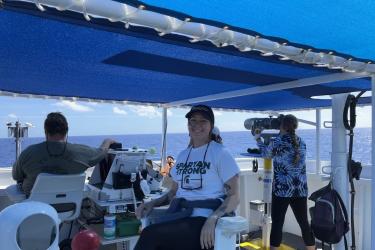Safety is our top priority for field operations, so we spent a week carefully preparing for emergency situations that could occur during the marine debris mission. Coincidentally, the weather sent us a few tropical storms that provided surf and wind for training.
“MD 1, this is MD4. This is a drill. Swimmer is in surf zone and needs assistance. This is a drill.”
“MD 1 copies. Dropping rescue swimmer in surf.”
After a rescue swimmer dropped into the water, they brought the “unconscious” swimmer back to the boat through the surf zone while the boat maneuvered and “held station” in the area. That was one of many drills we performed during our training in Kāneʻohe Bay, O‘ahu. We also swam as a team through heavy surf—assisting “injured” divers, removing a "net monster" in surf zones, and crossing channels with surf into open ocean.

You may be wondering: “What is a net monster?” Our dive instructor, Ray Boland, appropriately named it. The Net Monster is a tangle of fishing nets that we use for marine debris training. Our first interaction with Net Monster was during diver training when we were blindfolded and entangled in Net Monster while underwater on SCUBA. We had to remain calm and carefully disentangle ourselves without cutting the net. Overall, Net Monster was an excellent training tool for staying safe while collecting derelict fishing gear on our mission (and, not to mention, fun!).
We also teamed up and raced to cut a hauser line (thick docking line) and tie it back together while freediving.

While it may sound like a bad idea to flip a boat, we need to know how to right a boat in an emergency situation. After donning our life jackets and helmets, we set off in pairs to flip an inflatable boat over and then flip the boat back up again (or “right” the boat). After mastering this skill in calm water, we then practiced righting the inflatable boat in the surf zone. While we hope that we will never encounter any of these situations in the field, we feel extremely well prepared to safely handle them.

Between all of our safety drills, we also practiced towboarding. Towboarding is essentially being towed underwater behind a small boat. We towboard to look for marine debris that may be caught on the reef. Although our team favors towboarding, it’s actually pretty difficult to drive the boat with towboarders while manning the GPS. We need good GPS tracks and points for the data we collect, but also need to ensure that our divers are safe—all while maneuvering around the reef!
Luckily, we have an amazing, well-trained team, who all worked hard to prepare for our mission to Papahānaumokuākea Marine National Monument.
Meet the Blogger

Kelly Williams earned her master’s degree in Zoology from University of Hawai‘i at Mānoa researching shark sensory biology and behavior. If she is not in the water, Kelly is outdoors adventuring or with friends and family. Kelly is excited to get back to the Northwestern Hawaiian Islands, remove as much marine debris as possible, and bring awareness to this global issue.
You can make a difference
Buy reusable straws, use paper straws, and decline plastic straws. You can also encourage your favorite restaurants to serve drinks without straws (only upon request or not at all).
Follow us
Follow the team as we travel to the islands and atolls of the Northwestern Hawaiian Islands with photos and updates on our Story Map.
Partners
NOAA Fisheries marine debris project in the Pacific Islands region is supported by NOAA (Pacific Islands Fisheries Science Center, Pacific Islands Regional Office, Marine Debris Program, National Marine Sanctuaries, and the Damage Assessment Remediation and Restoration Program) in partnership with the University of Hawaii's Joint Institute for Marine and Atmospheric Research, National Fish and Wildlife Foundation, U.S. Fish and Wildlife Service, Midway Atoll National Wildlife Refuge, the State of Hawaii’s Department of Land and Natural Resources, and the Papahānaumokuākea Marine National Monument.

